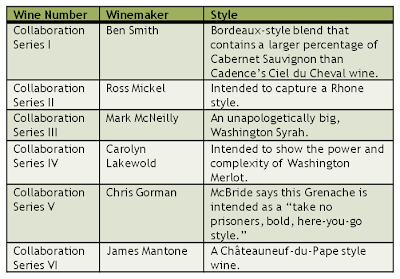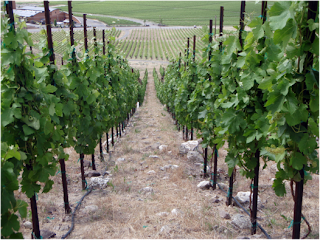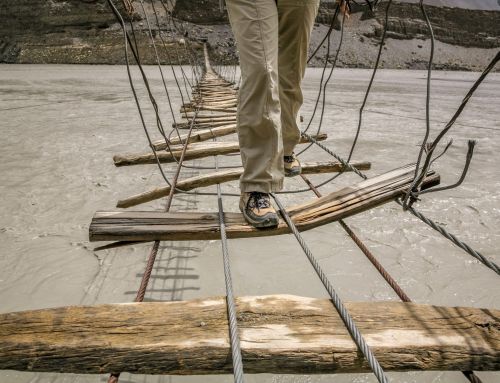What follows is a Focus report on Grand Rêve. Download a .pdf version of this report here. Read previous Focus reports here.

Our story starts when businessman Paul McBride moved to Washington in 1994. Before moving to the state, he didn’t know much about Washington wine. “I was a big California guy,” McBride says. “I didn’t really give Washington much credibility at all.” After relocating to Washington and tasting wines from some of the state’s finest wineries, including Quilceda Creek, Leonetti, and Woodward Canyon, McBride’s opinion of Washington started to change. He says, “It seemed like the handwriting was on the wall that Washington would become, in time, a world class wine producing area.” Still, McBride thought that time might be a ways off. He soon became interested in hastening Washington’s arrival on the world stage.

What he learned was that Red Mountain was the most highly regarded piece of wine real estate in Washington. Red Mountain’s prominence was reinforced after McBride asked a friend at a Silicon Valley bank about their lending policy for vineyards. His friend said the bank only considered lending for sites in ‘sure thing,’ well-established regions, such as Napa and Sonoma. There was, however, one exception – Red Mountain, Washington. The comment came with no knowledge that McBride was interested in Red Mountain. It was validation that he was on the right track.
The story continues with Ryan Johnson. Johnson works as vineyard manager at Red Mountain’s Ciel du Cheval, one of the most highly regarded vineyards in Washington State. Fruit from Ciel goes into many of Washington’s best wines, including those from Andrew Will, Betz Family Winery, Januik, McCrea, and numerous others. In a state that is placing an increasing emphasis on viticulture, Johnson is considered one of the best.
A number of years ago Johnson was approached by Ben Smith of Cadence Winery. Smith already owned a piece of property on Red Mountain and was interested in having Johnson establish a vineyard for him. At the time, Johnson was busy planting and managing new vineyard sites for DeLille Cellars and Quilceda Creek. He declined.

And in those words was an idea. Johnson would plant Smith’s vineyard in exchange for Smith making wine. Johnson would later sell the wine to recoup expenses. Johnson and Smith settled on two hundred cases. For the wine, Johnson would provide Smith with fruit from some of Ciel du Cheval’s oldest and most coveted blocks. While Johnson soon had the wine in hand, at that point there was no name or label to sell it under. Johnson says instead it was, “Hey, let’s get some great juice and have that in our back pocket.” Johnson figured the right opportunity would arise. It was about this time that he met Paul McBride met.
A Grand Collaboration

Around this time Long Shadows was beginning to make a name for itself by having world-renowned winemakers make wine from Washington fruit. Johnson and McBride envisioned a variation on this theme.
McBride says, “Ryan had a unique catbird’s seat having managed Ciel du Cheval for, this will be his twelfth vintage. Ciel sells fruit to the top thirty winemakers in the state. So he had been able to taste vintage after vintage after vintage.” Johnson’s experience made it easy to see who was doing special things with Ciel du Cheval fruit. Johnson and McBride wondered, what if, they created a winery that paired some of Washington’s best winemakers with fruit from one of the state’s best vineyards – Ciel du Cheval?
As the discussions evolved, Johnson and McBride began to talk about winemakers. They already had Ben Smith and the original wine from the 2004 vintage to use for the project. As they discussed other people, they made a bold decision. Rather than ask the state’s most established winemakers, they would ask some of Washington’s best up-and-coming winemakers. Johnson says, “We were kind of young and up and coming with our big dreams of doing something special on the farming side. And so it felt appropriate to match up with some of these rising star winemakers.”
Johnson and McBride chose people who they felt wine lovers would soon be excited about if they weren’t already. In addition to choosing winemakers on the way up, McBride and Johnson also focused on people they liked both personally and professionally. The wine, of course, was important too. McBride, says, “At the end of the day, the guys that we chose, we had to be able to like drinking their wines.”
The Collaboration Series Wines
The winemakers they approached were Ben Smith of Cadence; Ross Mickel of Ross Andrew; 
For the Collaboration Series wines, Grand Rêve has each winemaker make one wine that focuses on a particular style with a thematic purpose. McBride says, “We think each of these winemakers have a very distinct and unique approach to their wines.” However, McBride and Johnson were not just looking for the winemakers to remake their original wines under a different label. McBride says, “We don’t want them to just replicate their style. We want them to take an approach and create a wine that’s unique.”
For the project, each wine is given a Roman numeral, from I to VI. Each of the numbers corresponds to a specific winemaker. Although distinguishing wines differentiated by numbers can be difficult for consumers, McBride says, “The wines are like jersey numbers. If you ever get a Collaboration I wine, it’s Ben Smith.”
The Collaboration Series is not just a business venture. Johnson says, “We’ve developed friendships with these guys, so it’s one of these things where it’s very personal. I don’t want to disappoint them. They obviously don’t want to disappoint us, and there’s a bit of a friendly competition that goes on.” McBride adds, “We really like all of the guys we work with. We want this to be fun where everyone is going to benefit. It’s a true partnership in that regard.”
Wines Made in the Vineyard


Ben Smith has also made a reserve Syrah for the winery. This wine will be barrel aged for thirty-eight months. While this extended oak aging may seem extreme, Johnson says, “You don’t know what that maximum expression of anything is going to be until you push it…We have that flexibility to experiment and explore.”
Grand Rêve Vineyard

Johnson had already spent time investigating some of the world’s most famous wine regions that had vineyards planted in marginal conditions. One of those was Hermitage, known for its terraced vineyards. Johnson says of Hermitage, “Sane people wouldn’t consider planting there, but they are making some of the most compelling wines in the world.” Johnson and McBride began to consider doing something similar on Red Mountain.

The vineyard would be extremely challenging from the beginning. McBride says, “It is fun though and a little nerve wracking trying to do this for the first time. You can’t go to a book and say ‘how to plant hillside vineyards.’ You just look at it and you go, ‘Well what do you think Ryan?’ And he says, ‘I don’t know. What do you think?’ and I say, ‘Well, I don’t know.’”
They started with a soil analysis from Alan Busacca, digging a series of fifty-seven soil pits to assist with matching variety to soil type. What Busacca found was more complex than they could have imagined. There was no one-acre block that was completely uniform. Instead the blocks twisted and turned. In the end they arrived at thirty-four blocks – more “strips” Johnson says. The blocks were spread across thirteen plantable acres, although some may dispute the definition of ‘plantable.’
The elevation of the vineyard ranges from 960 to 1,230 feet and is, at times, at a considerable inclination. With much of the terrain steep and rocky, it took time to determine a plan of attack. Johnson says, “It took about a year to dream about it, to think about it, and to come up with a plan.” He continues, “I kept waking up at 2:30 in the morning in a cold sweat wondering, ‘How in the heck are we going to do this?’”
The vineyard is planted with extremely tight spacing, meter to meter and a half. Most of the blocks are less than one quarter of an acre in size. Like the soil underneath them, the blocks wind and weave. Johnson says, “Every block here is designed for the optimum way to express that corner of the vineyard. It’s a nightmare and I’ll probably regret this, but it’s not about ease of environment. It’s about making this the best vineyard we can.”

The vineyard workers have given specific blocks colorful names, some of which reflect the difficulty of the site, such as ‘El Terror’ and ‘The Devil’s Playground.’ McBride agrees that establishing the vineyard has not been easy, saying, “There were times we were cursing at (Ryan) and swearing at him. It will remain to be seen whether economically it will ever pay off, but we’re in it for the long term.”
What will come out of the Grand Rêve Vineyard in terms of wine? It remains to be seen. The first fruit from the vineyard will be harvested in 2010. While the Collaboration Series wines from Ciel du Cheval Vineyard focus on thematic styles, the Grand Rêve Vineyard wines will focus exclusively on expressing the vineyard site. McBride says, “We would like to have a distinctive wine that tastes like that site and like nowhere else.” Specific plans for the wines are still being determined. However, McBride and Johnson anticipate a hillside wine that will most likely be a Northern Rhone style and also a Southern Rhone-style wine. Additionally, there will be a focus on Bordeaux varietals lower down in the vineyard.
Elevating Washington Wine
Grand Rêve’s production is small and McBride and Johnson intend to keep it that way. The Collaboration Series wines from Ciel du Cheval will be about 1,000 cases and the Grand Rêve Vineyard wines will, over time, grow to 1,000 cases. A facility may eventually be built at the vineyard.
The Grand Reve project is unique and is intended to show just how far Washington has come as a wine region. McBride says, “When you think about the combined experience of all of these winemakers and Ryan and all of the viticulture that Jim Holmes has conveyed, this represents a huge culmination of the experience in Washington to date.”
While many would be out for money, fame, or both, McBride and Johnson’s say their impetus was simpler. McBride says, “Our goal was really just to help elevate Washington viticulture to the point where it would compare with the other great areas of the world. We want to show the world that Washington is a force to be reckoned with and that we can do some special, special stuff.” Similarly, Johnson says that, while some of the inspiration for the Grand Rêve Vineyard came from world-famous areas like Hermitage, Priorat, and Côte Rôtie, the winery will follow its own path. Johnson says, “We’re not trying to imitate. We’re inspired.” He finishes by saying, “If we can’t express our terroir through doing this, then I give up.”
Wine Reviews
Grand Rêve Collaboration Series I Red Wine Ciel du Cheval Red Mountain 2004 $55
Rating: ** (Exceptional) Drop dead gorgeous aromatics with black cherry, licorice, earth, and light mineral notes along with a dusting of chocolate. A nose to linger over for a long, long time. On the palate, beautifully structured with richer, more intense fruit flavors than often seen on the Cadence wines. Finish continues for as long as you want to count. 64% Cabernet Sauvignon, 18% Cabernet Franc, 18% Petit Verdot (co-fermented with Cabernet Franc). Aged 24 months in French oak (70% new). 14.5% Alcohol, 137 Cases produced. Ben Smith (Cadence) winemaker.
Grand Rêve Collaboration Series I Red Wine Ciel du Cheval Red Mountain 2006 $55
Rating: ** (Exceptional) Fairly closed up at the moment. Dusky spice and dust on a nose redolent with olive, currant, earth, and kisses of chocolate. On the taste, rich and intensely focused fruit and firm but polished tannins. More opulent than the 2004 offering. 63% Cabernet Sauvignon, 13% Cabernet Franc, 12% Petit Verdot, 12% Merlot. Aged in French oak (70% new). 14.5% alcohol. 200 cases produced. Ben Smith (Cadence) winemaker.
Grand Rêve Collaboration Series II Red Wine Ciel du Cheval Vineyard Red Mountain 2007 $45
Rating: ** (Exceptional) Brilliantly colored with a purple rim. A gorgeously appealing nose with a cornucopia of red fruit, earth, floral notes, and light game. Rich with luscious fruit on the palate. 55% Syrah, 25% Grenache, 19% Mourvedre, 1% Viognier. Aged in French oak (40% new). 14.8% alcohol. 184 cases produced. Ross Mickel (Ross Andrew) winemaker.
Grand Rêve Collaboration Series III Red Wine Ciel du Cheval Vineyard Red Mountain 2007 $45
Rating: ** (Exceptional) Purple in color. Closed up at present on a nose that shows chocolate, black fruit, raspberries, and floral notes. Remarkably restrained on a seamless palate marked by pretty red and black fruit. Give three years. 100% Syrah. Aged in French oak (34% new). 14.9% alcohol. 250 cases produced. Mark Ryan McNeilly (Mark Ryan) winemaker.
Grand Rêve Collaboration Series IV Red Wine Ciel du Cheval Vineyard Red Mountain 2006 $55
Rating: * (Excellent) Lots of cherry cola, Red Vines, and licorice on an aromatic nose. Rich and powerful on the taste with opulent amounts of fruit and velvety tannins. 75% Merlot, 13% Cabernet Sauvignon, 12% Cabernet Franc. Aged in French (60%) and American (40%) oak. 13.7% alcohol. 198 cases produced. Caryoln Lakewold (Donedei) winemaker.
Grand Rêve Collaboration Series V Red Wine Ciel du Cheval Vineyard Red Mountain 2008 $55
Rating: ** (Exceptional) A beautiful, complex aroma profile with violets, abundant red fruit, and minerals. An unapologetically big, rich, powerful, smack-you-in-the-face type of wine with gobs of red fruit. The alcohol level is high on this wine but it works. 90% Grenache, 10% Syrah. Aged 15 months in French Burgundy barrels (100% new). 15.5% Alcohol. 100 cases produced. To be released fall 2010. Chris Gorman (Gorman Winery) winemaker.
Grand Rêve Collaboration Series Reserve Cabernet Sauvignon 2007 Price To Be Determined
Rating: ** (Exceptional) Black licorice, light herbal streaks, coffee, high-toned fruit, and chocolate on an alluring, although still moderately closed up nose. On the palate, a complete ‘Wow!’ wine with a beautiful texture, incredibly focused fruit, and firm but appealing tannins. A statement of a Washington State Cabernet that is among the finest I have had. 100% Cabernet Sauvignon. Aged 24 months in French oak (100% new). 14.3% Alcohol. 100 cases produced. To be released fall 2010. Mark McNeilly (Mark Ryan) and Ross Mickel (Ross Andrew) winemakers.
Photos courtesy of Grand Rêve Vintners.







Grand Reve wines are awesome – I've been there to visit in Kirkland & Paul's juice rock! All consistant wines that are very impressive.
-WEKV
Ryan looks like GSP…pound-for-pound, the baddest bad-ass vineyard manager on Red Mountain! And a comedian, too.
~WAwineman
Without a doubt the most exciting winery in the state! I've had the privilege of tasting all of their wines thus far (including the Reserve Cab) and it is unbelievable how consistently outstanding all of their wines are! You cannot go wrong owning ANY wine from Grand Reve!
—–Scott
I agree that one of the most impressive things about this winery is the consistently high quality across wines and across vintages. Can't wait for the vineyard to come on line and see what it produces.
wow, what a great write-up, sean. i really like the pdf focus reports you're doing. as for grand reve, they're making some great stuff – my favorite out of the gate is the III, but probably because i'm also a mark ryan fan. i'm interested to see where they can take this – the future looks very bright…
Thanks RJ. I agree that the most fun part of this project is that they are just getting started and that they have set the bar extraordinarily high. Much to look forward to.
Dude,
You just continue to impress me (I'm sure that means a lot coming from a guy that says 'dude'!) with your writing and indepth reports. You are certainly the go to guy for anything Washington!
Thanks Jared. Much appreciated.
Wow Sean. I'm repeating here, but this is a great in depth, well written profile of a fabulous winery. Nice! Hope to drink some good wine with you soon.
Thanks Darren! Let's find some time to share some wine.
Sean, I really enjoyed this focus report and the ones that you did on Quilceda and on Betz. It gives your readers a fascinating look into what goes on behind the scenes to make what goes into our glass. Both interesting and informative. Bravo!
Thanks ChrisW!